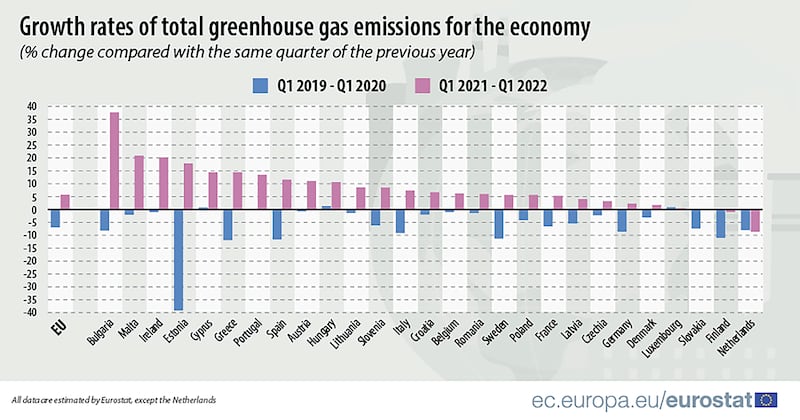Tánaiste Leo Varadkar has said Ireland can still meet the carbon emissions reduction targets in the Government’s Climate Action Plan, despite a new report showing that they have increased.
He was responding to new Eurostat figures which found Ireland had the third-biggest increase in EU greenhouse gas emissions among member states, according to the bloc’s statistics office.
The Netherlands (-9 per cent) and Finland (-1 per cent) were the only member states that registered a decrease in emissions in the first quarter of 2022 compared with the first quarter of 2021.
Among the members with the biggest rise in emissions in the same comparison period were Bulgaria (+38 per cent), Malta (+21 per cent) and Ireland (+20 per cent).
RM Block
Mr Vardkar said “in any one year, you can see figures that might not be reflective of how you’d see things over two or three years” and noted that emissions in Ireland fell for a number of years, before they increased last year.
Mr Varadkar said: “Last year was certainly a setback and we now need to redouble our efforts to reduce emissions from all sectors. “We have a Climate Action Plan and we’re making that happen and I think we can meet those targets.”

In July, after weeks of torturous negotiations, the Government agreed sectoral limits aimed at reducing carbon emissions by 51 per cent by 2030. This includes a 25 per cent reduction in greenhouse gas emissions from the agriculture sector by 2030.
Greenhouse gas emissions across the European Union rose in the first quarter from a year earlier but remained just below pre-Covid pandemic levels, Eurostat said.
Eurostat said greenhouse gas emissions from businesses, households and government activities amounted to 1,029 million tonnes of carbon dioxide equivalents, up 6 per cent year-on-year but below 1,035 million tonnes in the first quarter of 2019.
Households contributed 24 per cent of emissions for the period, Eurostat said, closely followed by the energy supply and manufacturing sectors, respectively accounting for 21 per cent and 20 per cent.
It added emissions increased in all sectors year-on-year - except for households where they were unchanged - reflecting an economic recovery from the pandemic.
The overall increase threatens the 27 member EU’s goal to reduce greenhouse gas emissions by at least 55 per cent by 2030 from 1990 levels, and reach net zero emissions by 2050 - a plan that entails the closure of coal-powered plants.
The war in Ukraine and the subsequent economic sanctions imposed on Russia - the EU’s main energy supplier - have prompted the bloc to save gas and store it this winter, fearing a total halt of Russian gas flows.
Some European countries are considering bringing back coal to achieve this target. Additional reporting: Reuters
(c) Copyright Thomson Reuters 2022

















